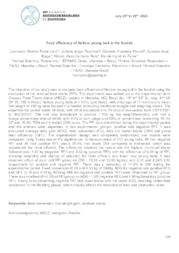Feed efficiency of Nellore young bull in the feedlot.
Feed efficiency of Nellore young bull in the feedlot.
Author(s): FERNANDES, L. O.; PASCHOAL, J. J.; MACIEL, G. A.; BRAGA, G. J.; REIS, N. J. C.; PAIVA, M. I. de
Summary: The objective of the study was to evaluate feed efficiency of Nellore young bull in the feedlot using the evaluation of the residual feed intake (RFI). The experiment was carried out at the experimental farm Orestes Prata Tibery Júnior (ABCZ), located in Uberaba, MG, Brazil (lat. 19º 47' 68" S.; long. 47º 58' 50'' W, 788 m West). Nellore young bulls (n = 101), pure breed, with initial age of 17 months and mean live weight of 486 kg were housed in a feedlot containing electronic troughs and weighing scales. The experimental period lasted 98 days, with 28 of adaptation and 70 days of evaluation, from 03/17/2021 to 06/23/2021. The diet was formulated to provide 1.700 kg live weight/head/day and had a forage:concentrate ratio of 40:60, with 40% of corn silage and 60% of concentrate, containing 15.3% CP and 76.8% TDN on dry matter (DM) basis. The RFI was determined during the experimental period and the animals were separated in two experimental groups: positive and negative RFI. It was evaluated average daily gain (ADG), feed conversion (FC), daily dry matter intake (DMI) and gross feed efficiency (GFE). The experimental design was completely randomized and means were compared using Tukey test at 5% significance. In the evaluation of 101 young bulls, 56 had negative RFI and 45 had positive RFI, about 55.4% had lower DMI compared to estimated, which was considered the most efficient. The difference between the lowest and the highest individual intake followed was -1.87 kg (negative RFI) and 3.52 kg (positive RFI), with the difference of 5.39 kg of RFI, showing variability and chance of selection for more efficient and lower cost young bulls. It was observed effect of youn bull RFI group on DMI - 13.59 and 12.05 kg/day, and 2.51 and 2.24% LW, respectively for positive and negative RFI. There was a reduction of 11.3% in DMI during the experimental period. Feed conversion (6.28 and 6.93 kg of DM/kg ADG for negative and positive RFI) and GFE (0.16 and 0.15 kg ADG/kg DMI for negative and positive RFI) were influenced by RFI group. There was no effect (P>0.05) of RFI group on ADG - 1.95 (negative RFI) and 1.98 kg/head/day (positive RFI). Young bulls presenting negative RFI had lower intake with the same ADG, enabling better-feed conversion in the finishing phase, which directly affects the reduction of feed and production costs.
Publication year: 2022
Types of publication: Abstract in annals or event proceedings
Unit: Embrapa Cerrados
Keywords: Ganho de Peso
Observation
Some of Embrapa's publications are published as ePub files. To read them, use or download one of the following free software options to your computer or mobile device. Android: Google Play Books; IOS: iBooks; Windows and Linux: Calibre.
Access other publications
Access the Agricultural Research Database (BDPA) to consult Embrapa's full library collection and records.
Visit Embrapa Bookstore to purchase books and other publications sold by Embrapa.

